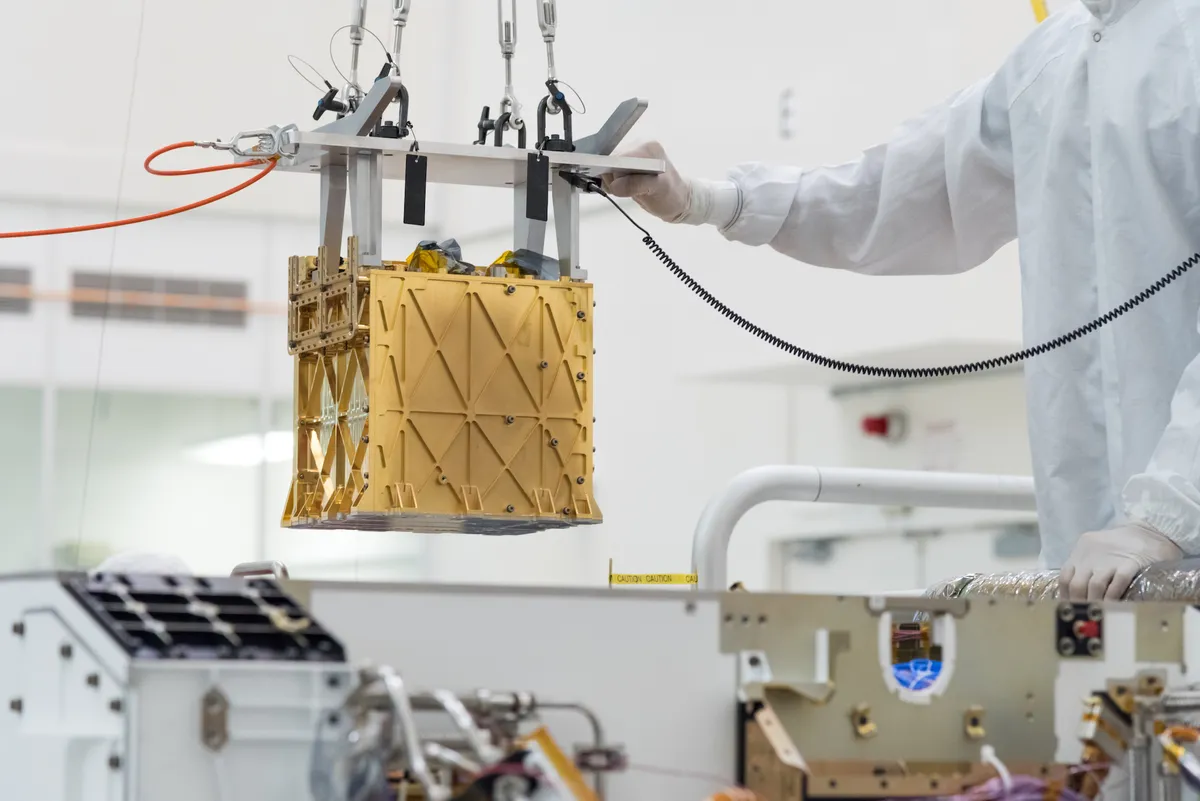It’s been a year since NASA's Perseverance arrived at the Red Planet, successfully completing the 471-million-kilometre, seven-month journey from Earth. After the nail-biting landing sequence, dubbed ‘seven minutes of terror’, the rover touched down to its new home, with the helicopter Ingenuity, strapped to its belly on 18 February 2021.
In that time, the dynamic duo has expanded our knowledge and understanding of Mars in a series of firsts, collecting over 50 gigabytes of data.
Here are some of the milestones Perseverance and Ingenuity have achieved, after a year on Mars.
Read more about Mars:
- Watch NASA’s Perseverance rover land on Mars
- How did Mars lose its atmosphere?
- There may still be active volcanoes on Mars
Taken lots of photos
The 23 cameras onboard Perseverance have been busy over the last year, and so far, have returned over 100,000 images of the Red Planet. These photos are already helping us to understand how the landscape was shaped by water, and will provide clues that will help guide the search for ancient microbial life.

NASA has made the raw images available to everyone, posting them in an online gallery, including a now-iconic selfie with Ingenuity. There are nine engineering cameras, seven science cameras and a further seven for entry, descent and landing.
Flew a helicopter, nineteen times
The helicopter Ingenuity took to the Martian skies on 19 April 2021, in the first-ever powered flight on another planet. There have been 19 successful flights so far, the most recent being on 8 February 2022, and it’s still going strong.
A game-changer for off-world exploration, Ingenuity is equipped with two cameras: a forward-facing 13-megapixel colour camera with stereoscopic imaging capabilities, and a downward-facing black and white navigation camera. With these cameras, Ingenuity is providing us with high-resolution images, but it’s also creating a high-fidelity 3D map of the Martian topography. Yes, the type of 3D image that jumps from the page when you wear those fetching red and blue glasses.
Generated oxygen
Perhaps one of the most exciting pieces of tech aboard Perseverance, is the Mars Oxygen In-Situ Resource Utilization Experiment (MOXIE). In another first for this mission, the gold, car battery-sized instrument made history when it created oxygen from the carbon dioxide in the thin Martian atmosphere. In other words, MOXIE will help provide humans with breathable air, and come home safely.
Using a process called solid oxide electrolysis, MOXIE works by drawing in CO2 from the atmosphere, compressing and filtering it to remove contaminants, then heating it to separate the oxygen and carbon monoxide. The carbon monoxide is expelled back into the atmosphere, while the oxygen is isolated by a hot, charged ceramic component, causing the oxygen ions to merge into the precious O2.

In April 2021, MOXIE generated about 5.4 grams of 98 per cent pure oxygen in one hour. To put that into perspective, this equates to approximately 10 minutes of breathable air for a human. But the process took a huge amount of energy and is currently limited by the power supply to 12g/hr – around the same as a large tree makes. Scientists hope that when scaled up (to around 100 times larger), this technology may be used to not only provide breathable air for future explorers, but also as a propellent, to lift astronauts off the surface.
Collected samples
So far, Perseverance has taken six samples of the Martian rock and atmosphere, while scientists back home eagerly anticipate, and plan for their return.

On 1 September 2021, Perseverance drilled 6cm into the Martian surface and extracted a rock core, carefully sealing it in a tube. This achievement marked the first time a spacecraft has ever taken samples from another planet that could eventually be returned to Earth.
Here on Earth, we can analyse the samples with technology too big or complex for Mars, and engineers have begun testing the robotics needed for a sample return mission. NASA and ESA are currently solidifying concepts for such a mission, but it’s likely to be a while – closer to the end of the decade.
Confirmed a watery past
Analysis of one of the crater’s most massive geologic features, the ‘Delta Scarp’, has confirmed the Jezero crater, which today is a dry, wind-eroded depression, was an ancient lake fed steadily by a 120-mile-long river around 3.7 billion years ago. Consistent with this, the crater also contains a triangular-shaped delta, where the river fed into the lake in the distant past.

It’s likely that the river delta was mostly calm, but there is evidence for high energy flooding in the area, transforming the slow meandering waterway into fast-moving flash floods. Perhaps caused by a dramatic shift in climate, these waters were strong enough to carry large boulders downstream, before depositing them in the lakebed.
Now that we know the landing area was once a lake environment, it’s possible that underlying sediments could reveal evidence of ancient aqueous life.
“We now have the opportunity to look for fossils,” says team member Tanja Bosak, professor of geobiology at MIT. “It will take some time to get to the rocks that we really hope to sample for signs of life. So, it’s a marathon, with a lot of potential.”
But it’s not just Perseverance making waves. The Mars Reconnaissance Orbiter has found that water flowed on Mars for longer than previously thought, publishing their findings in AGU Advances. Curiosity meanwhile, which is still exploring the base of Mount Sharp, has discovered that Mars underwent a series of large-scale fluctuations between wetter and dryer periods, before drying up completely around 3 billion years ago.
The floor is lava
One of the areas that Perseverance is investigating has been nicknamed ‘Séítah’ (meaning ‘amongst the sand’ in the Navajo language). Initially, it was thought that the geology in this area was sedimentary in origin, with layers of rocks formed by the consolidation of sediment from either water or wind.
But when the rover scraped the surface of these rocks with its abrasion tool, instead of sedimentary rocks, they found that the crater floor was composed of coarser-grained igneous minerals, perhaps laid down as the result of an ancient lava flow. They also found a variety of salts in the rocks.

“The idea that this could be a volcanic rock was really appealing to us from a sample return perspective because igneous rocks are great for getting accurate age dates. Jezero was one of the few ancient crater lake sites on Mars that seemed to have both incredible sedimentary deposits as well as volcanic deposits that could help us construct the geologic time scale of Mars,” said Kathryn Stack Morgan, the Mars 2020 Deputy Project Scientist and research scientist at JPL.
The presence of olivine crystals engulfed by the mineral pyroxene at Séítah indicates that after the igneous rocks were laid down, water flowed through the spaces in the rocks, which precipitated these minerals from the water. In other words, the minerals were produced as a result of the interactions between the igneous rock and water.
“The rocks of the crater floor were not originally envisioned as the prime astrobiology target of the mission, but Mars always surprises us when we look up close. We are excited to find that even these rocks have experienced sustained interaction with water and could have been habitable for ancient Martian microbes,” said Stack Morgan.
Discovered organic molecules
Carbon-containing organic chemicals have been discovered in some of the rocks in the Jezero Crater, by the Scanning Habitable Environments with Raman & Luminescence for Organics and Chemicals (SHERLOC) instrument. The molecules containing the carbon have been found in both the interior of abraded rocks, and in the dust on the non-abraded rock.
[image id="111867" size="full" align="none" title="SHERLOC's View of Organics Within Garde Abrasion Patch © NASA:JPL-Caltech:MSSS:LANL:PhotonSys" alt="Different kinds of carbon-based molecules called organic compounds were viewed within a rock target by SHERLOC, one of the instruments on the end of Perseverances robotic arm. ©" classes=""] Different kinds of carbon-based molecules called organic compounds were viewed within a rock target by SHERLOC, one of the instruments on the end of Perseverances robotic arm. © NASA/JPL-Caltech/MSSS/LANL/PhotonSysHowever, this is not necessarily a confirmation that life once existed on the Red Planet, as there are also non-biological mechanisms that create organics.
“This is a question that may not be solved until the samples are returned to Earth, but the preservation of organics is very exciting. When these samples are returned to Earth, they will be a source of scientific inquiry and discovery for many years,” Luther Beegle of JPL said in a statement.
Read more about the planets: